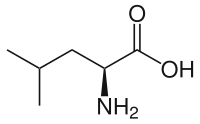
Photo from wikipedia
Diamino-oxidase (DAO), horseradish peroxidase (HRP), and tetramethylbenzidine (TMB) have been immobilized into cellulose to obtain circular cellulose test supports (CCTSs) for the determination of cadaverine (Cad) and putrescine (Put). During… Click to show full abstract
Diamino-oxidase (DAO), horseradish peroxidase (HRP), and tetramethylbenzidine (TMB) have been immobilized into cellulose to obtain circular cellulose test supports (CCTSs) for the determination of cadaverine (Cad) and putrescine (Put). During the enzymatic reaction, TMB is oxidized and a blue spot is obtained. This color (RGB coordinates) is measured with a smartphone and a commercial application. The highest sensitivity is provided by the component R and a linear response is observed for low biogenic amine (BA) concentrations, but a second-order polynomial response better fits the experimental results for a wider concentration range. This has been successfully explained with a model developed to explain the RGB values obtained in this type of analytical system. Optimization studies enable CCTSs to be obtained for Put and Cad determination, which could be used (kept at 4 °C) for at least 45 days if a stabilizer (StabilCoat™ or StabilGuard™) is added during its synthesis. In these conditions, the R coordinate follows the model up to at least 4 × 10 −4 M Put and/or Cad (both analytes give the same response). The method permits the Put and Cad determination from 5 × 10 −5 M up to 4 × 10 −4 M (RSD = 3%, n = 3). The CCTSs have been applied to Put + Cad determination in a tuna sample without any interference by other biogenic amines. The concentration found statistically agrees with that obtained using a HPLC-MS-validated method. Graphical abstract
Journal Title: Analytical and Bioanalytical Chemistry
Year Published: 2020
Link to full text (if available)
Share on Social Media: Sign Up to like & get
recommendations!